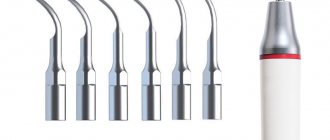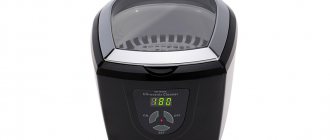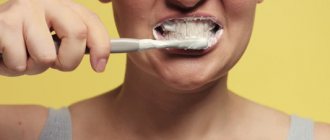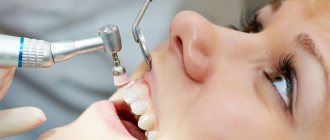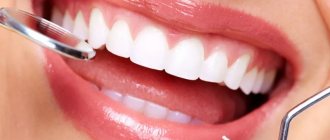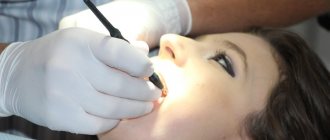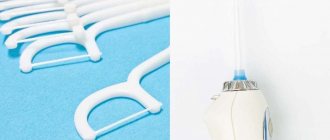For a couple of decades, patients of dental clinics who were not classified as VIPs had access to only 3 main services:
- dental treatment;
- deletion;
- prosthetics.
Today the range of services has expanded significantly. If the patient comes to the doctor on time, he will be able (in most cases) to save his teeth and avoid multiple dentures. It is interesting that even for people suffering from periodontitis, which previously almost guaranteed to lead to the loss of practically healthy teeth, in our time there are ways to restore health to the gums and stop the process of thinning of bone tissue.
One of the new methods that prevents and relieves gum inflammation is cleaning with the Vector device. Let's figure out what this technique is.
Indications
Vector teeth cleaning is, in essence, a treatment. Using the device, the doctor cleans and polishes the crowns, and also specifically affects the gums and subgingival pockets (if they have already formed).
How does the Vector device work?
Main indications:
- tartar (the device effectively removes deposits in the most inaccessible places);
- soft coating;
- gingivitis;
- periodontitis;
- periodontal disease.
“Vector” gives a real chance to eliminate the symptoms of inflammatory gum diseases, stops destructive processes, and therefore the technique is in demand among patients who find it difficult to clean and whiten their teeth using other methods.
Acute inflammation (occurs when periodontal pockets suppurate, gums are damaged by a tooth fragment or a crown) is an obstacle for many of them. “Vector” is approved for use.
Cleaning process
Using Vector, patients get by with 2-3 cleaning procedures. There is no need for surgical intervention when a gum flap is sewn to the tooth, eliminating the periodontal pocket. When cleaning, the affected tissue is removed, and the gum itself fits tightly to the tooth again.
What is Vector
“Vector” is an ultrasonic device developed by German scientists at Durr Dental to remove all types of bacterial deposits from the oral cavity (soft and hard mineralized plaque). With its help, a thorough treatment of the teeth, the space above and below the gums (in periodontal pockets) is carried out.
In fact, Durr Dental supplies the medical services market with a whole complex consisting of several devices:
- Vector Scaler: a regular ultrasonic scaler (scaler), no different from many devices from other manufacturers. Used for professional hygienic cleaning in a dental office,
- Vector Paro: is positioned by the manufacturer as a tool that helps in the treatment and prevention of periodontal diseases. Promotes high-quality and complete removal of plaque not only from all visible surfaces (teeth, gums), but also from under the gums, and it is subgingival deposits that are the main provocateurs of inflammation in periodontal tissues. Vector Paro is of practical interest to specialists, and therefore is mostly used in dental clinics. We will talk about its features further.
Advantages and disadvantages
Does your doctor recommend brushing your teeth with Vector? Agree. Advantages of such cleaning:
- painlessness;
- the ability to remove well-camouflaged deposits;
- preparation of deep periodontal pockets;
- low traumatic.
There are much fewer cons. Doctors complain that it is not always possible to remove tartar from all sides. Occasionally (when using unsuitable attachments), the patient suffers injury to nearby tissues. But such a situation is not excluded even with simple ultrasonic cleaning. That's all the negative sides of manipulation.
Features of the Vector Paro device
This device also uses ultrasonic teeth cleaning. However, it has a number of differences from standard ultrasound devices.
Vertical impact
The main feature of the device is that a special nozzle has been created for it, the tip of which is located vertically (parallel) in relation to the surface of the dentition and roots, and not horizontally, as is the case with conventional scalers. Ultrasound is also supplied only in the vertical direction, that is, from bottom to top and top to bottom, while in classical devices vibrations occur in all directions.
All this contributes to guaranteed soft, comfortable, painless removal of deposits, as well as gentle and gentle periodontal therapy. During the procedure, the doctor does not injure the tissue, but at the same time has the opportunity to penetrate the periodontal pockets as deeply as possible and clean them efficiently.
On a note! The design and functional features of the Vector Paro nozzle make the cleaning process delicate, fully controlled and predictable. The nozzle does not create oscillatory [1] or vibrating movements, does not heat up, and the doctor has the ability to adjust the amplitude of the waves during the procedure.
Using a special aqueous solution
Conventional ultrasound machines use distilled water, which helps cool tissues and protect them from overheating, wash away deposits, and improve the propagation of ultrasonic waves.
Vector teeth cleaning involves the use of a special Vector Fluid polish solution containing hydroxyapatite granules. The product helps to ideally polish the surface of the enamel and roots, which subsequently slows down the process of bacterial plaque accumulation on them, which means it prevents the progression of gum inflammation.
The solution also helps reduce the sensitivity of soft and hard tissues, promotes regeneration and speedy healing of inflamed areas. The liquid has a mint aroma, which makes your breath fresh.
Treatment with the “Vector” device
The ultrasonic cleaning system is suitable for the treatment of various types of gum diseases: periodontal disease, periodontitis, gingivitis.
Periodontal disease
Good news for those suffering from periodontal disease: “Vector” not only removes tartar, but also allows you to stop the destructive process.
Periodontal disease is not as common in dental practice as periodontitis, but anyone who has problems with the tissues surrounding the tooth is at risk. With periodontal disease, there is no inflammation as such, but there is dystrophic destruction of the periodontal tissues.
The gums undergo recession. Advanced periodontitis leads to periodontal disease. The disease is more often diagnosed in elderly patients in whom pathological changes are caused by age-related characteristics.
Periodontal disease leads to tooth loss. Due to thinning of the bone tissue, it is then difficult to place dentures.
Periodontitis
Periodontitis develops due to:
- poor oral hygiene;
- untreated gingivitis;
- malocclusion;
- crowded teeth;
- the presence of hard dental plaque.
At first, it bothers you at times, manifesting itself as pain when trying to eat sweet, cold or hot food. The gums become red or bluish and bleed.
If the disease is not treated, the gum tissue gradually separates from the crown, forming a pocket where bacteria can enter. The patient feels pain, others feel an unpleasant odor emanating from the inflamed pockets.
Using the Vector ultrasonic cleaning system, the doctor:
- removes diseased tissue;
- treats inflamed areas and pockets, as a result of which the gums fit tightly to the teeth again;
- polishes teeth after the procedure.
In 1-2 sessions you can get rid of exacerbation of periodontitis. Then you need to come for preventive examinations and repeat treatment if the dentist discovers a relapse of the disease.
Gingivitis
Gingivitis is the easiest thing to deal with. Having cured the gums at the stage of gingivitis, a person will not encounter such complications as periodontitis.
Symptoms of gingivitis:
- bad breath;
- cyanosis of the gums (redness);
- inflammation of the interdental papillae.
There are no pockets yet - it is enough to clean them once with Vector so that they never appear.
Recommendations to be followed after the procedure
As after any ultrasonic cleaning, after manipulations with the Vector device, doctors recommend that patients adhere to several rules over the next 2-3 days:
- you need to refrain from eating food and drinks that are coloring, too cold and hot dishes, solid foods, sour and spicy foods,
- It is recommended to eat mainly soft and liquid foods,
- you shouldn't smoke
- Oral hygiene is best done with a brush with soft bristles and toothpaste marked Sensitive: after cleaning, it is important to purchase a new brush, since the old one harbors pathogenic bacteria.
2-3 months after the first procedure (or course of procedures), it is important to conduct a follow-up examination. Be sure to visit a doctor even though your gums begin to look healthy on the outside. Remember that achieving a lasting positive effect is possible only with subsequent maintenance therapy, especially in those patients who suffer from gingivitis and periodontitis.
How does cleaning work?
Cleansing with a new device is a process that takes 40 minutes (if there are no special difficulties).
Stages:
- examination of the oral cavity;
- treatment of caries and pulpitis;
- using Vector for professional cleaning.
The device is a system of 2 devices: the first is called Vector Paro. It was invented recently and just helps get rid of gum disease.
The second is the Vector Scaler - a familiar ultrasonic scaler that removes soft and hard dental plaque.
Device Vector
The doctor uses both tools during the work process.
"Vector" is equipped with 30 attachments. This allows the dentist to choose which one to use to treat periodontitis or periodontal disease, and which one to simply remove soft tartar from the enamel.
The doctor applies a therapeutic mixture based on hydroxyapatite to the tip of the device. Its purpose is to promote the speedy healing of micro-wounds that will be caused during treatment with the device. The patient will not feel pain; therefore, anesthesia is not used for such cleaning. Maximum – slightly unpleasant sensations when cleaning deep cavities. They are experienced by patients with a low pain threshold. The patient is placed in a chair, the doctor turns on the device and sequentially cleans all teeth and gums.
Two important differences between Vector and other methods:
- the dentist cleans pockets to a depth of 11–12 mm (other devices only allow penetration to 4 mm);
- Instead of distilled water, a paste with hydroxyapatite, anti-inflammatory and regenerating, is served.
In addition, the device does not heat up. Typically, when heating, in order to prevent its undesirable consequences, the dentist applies cooling, which results in the formation of an aerosol cloud. It contains microbes, from which neither the doctor nor the patient is 100% protected from entering the body. Using “Vector” eliminates this.
Sometimes cleaning can take an hour or longer if there is a lot of deposits. The matter may not be limited to one session, then the patient comes a second time to finally get rid of plaque and treat the gums.
Bonus for those who are not satisfied with the natural color of the enamel: after such cleaning, the crowns turn white. True, it’s only a half tone, but there is an effect.
Efficiency of the procedure
Treatment of periodontitis will be successful if VECTOR therapy is used. The device operates delicately. The depth of influence is within 11 millimeters. In this case, tissues are not injured. Positive results appear immediately. The tool is able to rid tooth roots of pathological film. After treatment, the adherence of the gum tissue to the unit becomes tight. It is important that such therapy does not leave scars. Besides:
- Dirt is removed even from the bottom of the pockets;
- The position of the tool changes minimally;
- The patient does not feel discomfort;
- Cleansing is complemented by polishing;
- Gentle cleaning with a flexible nozzle;
After such therapy, the gum tissue becomes healthy, dense, with a pink tint. Regular treatment stabilizes the condition of the soft tissues of the oral cavity for a long time.
Postoperative period
Teeth and gums do not require special care after brushing.
Dentists recommend:
- in the first 2–3 days, refrain from taking coloring drinks and food;
- on the first evening, brush your teeth with a soft brush or simply rinse your mouth;
- 14 days after the procedure, come for examination.
If everything goes well, the treated gums are healing, the doctor schedules a follow-up visit after 1.5 months.
Treatment results:
- healthy gums;
- decreased tooth mobility;
- strengthening soft tissues.
The result lasts from a year to a year and a half.
Reviews
Treatment with “Vector” is a new technique. Like everything new, it causes concern among patients. Don’t worry: today there are those who have already tried the action of vector cleaning. In most cases they are happy with the result.
Reviews testify to this.
Catherine
“I have a lot of fillings, including old ones, and I have 2 crowns. During the examination, the doctor noted the initial signs of gingivitis and suggested vector cleaning. I agreed. I thought that this medical manipulation could not be performed with such fillings, but the dentist said that, on the contrary, it was “Vector” that would allow us to get to the places where the crowns and filling material came into contact with living tissue. The raid is gone! My teeth turned white. I’m happy with the result, I recommend it to everyone.”
Andrey
“I used Vector cleaning twice. The result lasts me for 2 years. There is no plaque, although I drink a lot of coffee.”
Natalia
“Due to crowding of teeth, periodontitis appeared. The tooth hurt, I thought it was caries, but it turned out that a pocket had formed and the root of the tooth was exposed, hence the pain. After vector cleaning, the pocket disappeared. I can eat my favorite chocolates – there is no more pain!”
Advice from Dr. Zubastik
Ideally, you should prevent the development of serious diseases of the teeth and gums by seeing a doctor once a year for prevention. But if periodontitis is already making itself felt, the situation is not hopeless. Today it can be cured! Contact your dentist.
Remember: vector cleaning will stop the progression of oral diseases and keep your smile beautiful.
To make it easier to decide to brush your teeth with Vector, see how it works.
Tags: vector, brushing teeth
About the author: Dr. Zubastik
Typically, a toothache begins to subside on the way to the clinic and finally goes away after 10 minutes of sitting in line to see the dentist.
- Related Posts
- All the nuances of flossing teeth
- Step-by-step instructions in pictures on how to brush your teeth and do it correctly
- How to brush teeth with braces: instructions with pictures
« Previous entry
Information about disadvantages
As for the disadvantages, they also exist. Ultrasonic teeth cleaning using the Vector device is a procedure that has a fairly high price.
The manipulation is also not suitable for all clinical cases. For example, deposits that are too deep cannot be removed using the device. Patients with a similar problem will have to undergo surgical measures that involve peeling off the gums and suturing at the final stage of cleaning, as well as a long rehabilitation period.
Cleaning with the Vector device is not a panacea. As an independent measure, the procedure will not get rid of gingivitis and periodontitis. You need to understand that these diseases are treated with a whole range of measures.

